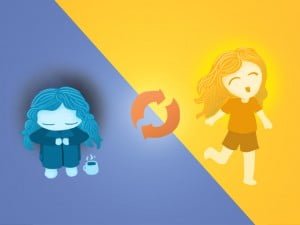 It is that time of year again, the tail end of winter. We’ve all been living with winter for months now, and it can be taking a toll on our psychological wellbeing. It is very likely that we might be suffering from Seasonal Affective Disorder (SAD), and not even know it. Seasonal Affective Disorder (SAD) is a type of depression that is associated with the changing of the seasons of the year. It is something that affects everyone. As home health care caregivers, we must be especially aware of its influence on us and our caregiving. It is important that we have a positive and empathetic attitude toward all of our clients. Don’t let Seasonal Affective Disorder (SAD) stand in the way of your caregiving. We also need to consciously realize that our clients may also be suffering from Seasonal Affective Disorder (SAD.) This might explain why a client is acting a certain way towards us. As health care professionals, it is our job to understand this, and make sure we react appropriately during our interactions with our clients.
It is that time of year again, the tail end of winter. We’ve all been living with winter for months now, and it can be taking a toll on our psychological wellbeing. It is very likely that we might be suffering from Seasonal Affective Disorder (SAD), and not even know it. Seasonal Affective Disorder (SAD) is a type of depression that is associated with the changing of the seasons of the year. It is something that affects everyone. As home health care caregivers, we must be especially aware of its influence on us and our caregiving. It is important that we have a positive and empathetic attitude toward all of our clients. Don’t let Seasonal Affective Disorder (SAD) stand in the way of your caregiving. We also need to consciously realize that our clients may also be suffering from Seasonal Affective Disorder (SAD.) This might explain why a client is acting a certain way towards us. As health care professionals, it is our job to understand this, and make sure we react appropriately during our interactions with our clients.
The causes of Seasonal Affective Disorder (SAD) are unknown, but psychologists have a few theories. They include:
- A shock to our circadian rhythm or biological clock
- A drop in Serotonin levels, a chemical in our brain that affects moods
- A drop in our Melatonin levels, a chemical in our bodies that plays a key role in sleep patterns and mood
Some of the factors that psychologists believe may increase your risk of suffering from Seasonal Affective Disorder (SAD) include:
- Age – Younger people have a higher risk
- Gender – Females are more likely to be at risk
- Family History
- Having other forms of depression can increase your risk
- Living further from the equator – longer days with minimal or excessive sunlight can increase your risk
The two main types of Seasonal Affective Disorder (SAD) are “Winter-Onset Depression” and “Summer-Onset Depression.” The symptoms of Winter-Onset Depression include:
- Irritability and anxiety
- Tiredness and drop in energy levels
- Problems getting along with others
- Hypersensitivity to social rejection
- Physical problems, such as headaches and a heavy “leaden” feeling in the arms or legs
- Oversleeping
- Difficulty concentrating
- Appetite changes, especially a craving for foods high in carbohydrates
- Weight gain
The symptoms of the less common type of Seasonal Affective Disorder (SAD,) Summer-Onset Depression include:
- Irritability
- Trouble sleeping or insomnia
- Weight loss
- Poor appetite
- Agitation or anxiety
As you can tell by the symptoms, Seasonal Affective Disorder (SAD) can have a severe impact on our home care caregiving if we allow it. As home health care caregivers, we need to understand that our clients are in a vulnerable condition. If they weren’t in a vulnerable condition, they wouldn’t need the assistance of home health care. This vulnerability can lead some clients to a depressive and defensive state. Seasonal Affective Disorder (SAD) can amplify this state. A client may unintentionally react defensively to you, especially if your relationship with the client is new. In the caregiver’s eyes, this reaction may make the client seem mean, unkind, and/or undesiring of help. As a health care professional, we need to know how to react in this situation to calm and console the client. This situation should be looked at as an opportunity to let a vulnerable client know that your true intensions are only to help and to provide quality care. You need to set a foundation to build a trusting relationship. Home health care can be a very rewarding line of work. This trusting relationship is one of those rewards.
Recent Comments